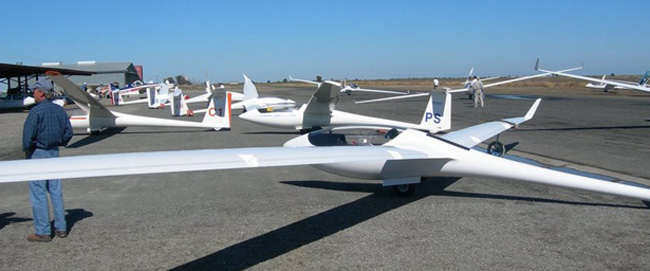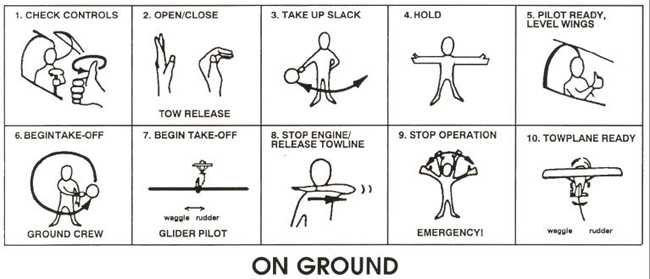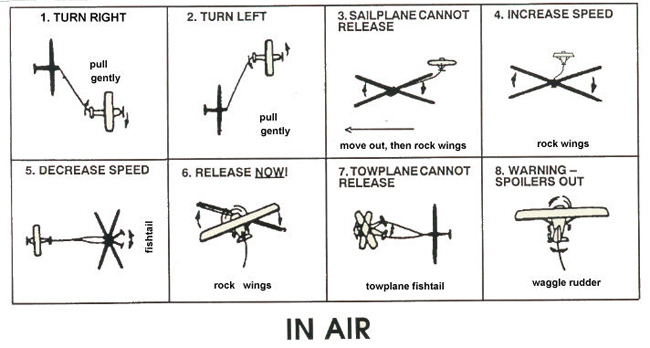Pilots & Students Responsibilities

Williams Soaring can be a very busy airport (photo by Gen Shibayama - GS)
Activities by pilots and clubs
The Williams Gliderport is a privately owned, commercial operation. Rated Pilots are valued clients of the gliderport; however, activities that are provided by the staff of the gliderport may not be conducted by pilots without explicit approval and coordination with the management. This includes, conducting ground or flight instruction, providing rides for hire, or any other service for payment by passengers. This policy applies to flights in gliders that are privately owned as well as gliders rented from Williams.
Currency and qualification
Unless a pilot is renting equipment, the management and staff of the gliderport do not monitor, either the currency or the qualifications of licensed glider pilots. The management representative may ask to see your pilot credentials when the registration card is completed. The registration card must be completed prior to conducting operations. Tows will not be provided to pilots who are known to be either non-current or unqualified.
Pilots & Student glider pilot responsibilities
Pilots not rated in gliders, may not fly at Williams unless under the direct supervision of an instructor. Student Glider Pilots must carry documentation and credentials with them which prove they are under the supervision of an instructor on every flight, just as a licensed pilot, rated in gliders is required to carry the appropriate certifications.When flying solo, a student pilot is the pilot in command, and as such, must comply with all applicable rules and regulations (FAR's). Pilots must comply with all applicable Federal Aviation Regulations (FAR's).
[ Top of Page ]
The Pilot Information Form
- Open, fill out, and print the Pilot Information Form (13KB Adobe pdf file).
- The Pilot Information form must be completed by each pilot-in-command prior to operating from this field. Download and print the Pilot Registration Form. After you fill in your information, bring it with you to the Williams Soaring Center Office.
- The form will be a current record of the following information:
- Pilot Info: name, address, phone numbers
- Emergency Contact Info: name, address, phone numbers
- Pilot Qualifications (Certificate number and ratings)
- Williams glider check outs (to be filled in by Williams Soaring Staff)
- Date of last biennial flight review
- Information should be updated as necessary, be sure to notify the Williams Soaring Center when the information changes.
- Your signature acknowledges that you have read and understand the information presented on these pages of "Pilot Information - Required Reading."
Motor Vehicles, Glider Trailers and Tiedowns
- SPEED LIMIT under 5 MPH at all times on the airport property. Avoid driving across the runway, and park motor vehicles only
in designated areas.
NOTE: these areas change depending on whether it is WET or DRY. - The area between the workshop hangar and the runway should remain clear. This includes gliders, and glider trailers, as well as motor vehicles. The clear space at the front of the hangar is used to provide a safety margin of clearance for airplanes that are conducting takeoffs and landings.
Glider trailer parking and glider assembly
- Coordinate trailer parking location with field manager.
- After assembly, do not leave the glider unattended until it is tied down.
- Consider the space required for gliders in adjacent trailers.
- Put your glider ramp back into the trailer to leave setup room for the adjacent gliders.
Glider tiedown
- Gliders should remain secured until being positioned for takeoff and should again be secured as soon as practical after landing to prevent injury or damage.
- Never leave the tail dolly installed if the glider will not be constantly controlled. Inadvertent rotation may occur suddenly with a gust of wind, if the tail dolly is installed.
[ Top of Page ]
Rentals
- Pilot must show license and proof of currency. A photo copy may be made of the pilot certificate, and pilot should state the date of the last biennial flight review
- Pilot must demonstrate proficiency prior to rental
- Any pilot that has not flown in the previous 90 days, will be required to make a minimum of one dual flight with a WSC Instructor before renting WSC aircraft.
- Pilot must comply with insurance requirements
Express Permission Required
Pilots renting gliders from Williams Soaring Center do not have the right to use them in any manner they choose, other than for normal gliding and soaring. Express permission must be received for any other activities, such as cross-country flights, operating from the rear seat, aerobatics, formation with other aircraft, air-to-air photography, etc.
Scheduling
Instructor time and the ASK21's are reserved for 2 hours of use per pilot per day starting at 8:00. Longer blocks of time may be scheduled by special arrangement.
Single place gliders are reserved in 1 hour blocks starting at 8:00. A pilot is responsible for rental charges at 60% of the reserved time, regardless of the soaring conditions. (not applicable if the weather conditions prohibit safe flight operations)
Only Williams Staff members will make reservations in the scheduling book. Please be sure to phone or email Williams Soaring to be added to the schedule. If you send an email, do NOT assume that you are on the schedule until you receive a confirming email. If in doubt, CALL.
Cancellation of Reservations
If a cancellation is requested less than 24 hours prior to the reservation, then the person holding the reservation may be liable for 50 percent of the scheduled services, to include rental time on the glider, and scheduled ground and flight instruction time.
[ Top of Page ]
Retrieves
Retrieval is at the discretion of Williams Soaring Center and will be determined on a case-by-case basis.
Aero Retrieves
- Policy - Only from approved airfields, subject to WSC and Tow pilot discretion.
- Rate - Based on the time the tow plane is gone from WSC. Rates are based on total time that the Tow plane is gone from Williams Soaring - charges are for "round trip". See latest rate schedule in the office, or view the Airport Rates, Fees, & Charges page. (Fuel prices have been going up!)
Ground Retrieves
- Policy - Each ground retrieval will be evaluated
on a case by case basis. However, the general polices are as follows:
- Retrieval of Rental Gliders will be carried out under the supervision of a WSC Staff Member.
- Gliders rented from WSC will be retrieved when staff personnel become available.
- Assistance with ground retrieve of privately owned gliders is strictly subject to availability of personnel. The supervision of private retrieves is the responsibility of the pilot. Retrieve charges apply in both cases.
- Rate - applicable charges:
(see Airport-Rates for current charges)
- Retrieve Charges - There is a flat retrieval initiation charges, plus a per person hourly charge for the total people required to accomplish the retrieval. See Airport-Rates.
- Glider Rental Charges - Normal glider rental charges will apply daily, until the glider is reassembled and once again available for service. Maximum of five hours per day).
- Mileage Charges - where applicable.
[ Top of Page ]
Standard Visual Glider Signals
Standard visual signals should be used at all times. The use of visual signals, in conjunction with clear concise radio communications will keep everyone aware of the situation, even those on the field who may not be monitoring the radio, but are observing the operations.The standard visual signals are as follows:
![]() View Soaring Signals Adobe PDF file for printing.
View Soaring Signals Adobe PDF file for printing.
Signals to be used on the ground:

Signals to be used in the air:

[ Top of Page ]
